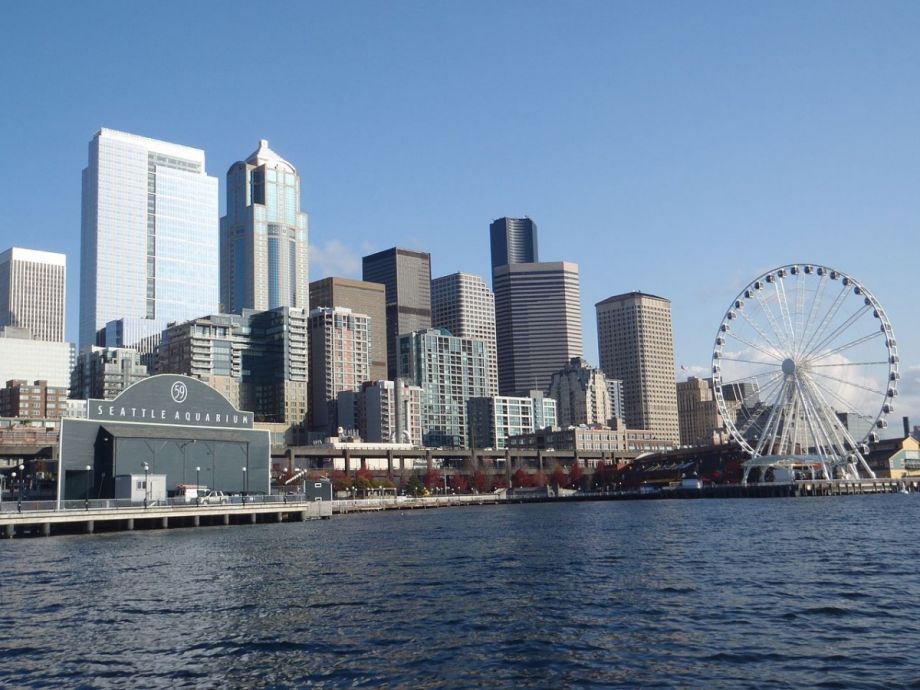Seattle is surrounded by natural beauty: Rugged mountains to the east and west, a giant volcano to the south, and Puget Sound lapping against the western edge of downtown. One of the best places to take in the sites (at least as a car passenger) is the top of the Alaskan Way viaduct, a double-decker highway that runs north to south along the waterfront and provides unobstructed views of the Olympic mountains, Puget Sound and the Seattle skyline.
But the viaduct’s days are numbered. A 2001 earthquake damaged the highway and it is being torn down and replaced by a tunnel.
The city’s Office of the Waterfront is using the freed-up space to reshape the waterfront with a promenade, a protected bike lane, a park and an elevated ramp that takes people over the new surface street from Pike Place Market down to the waterfront (and provides similar views, according to the city) and more. Phase one, which includes rebuilding an ancient seawall, is currently underway.
One Seattle activist says their park plans are not enough, however, and is fighting to preserve those elevated highway views and wrest control of the waterfront project from the city.
“We’re very confidant that introducing [an elevated park] into the waterfront plan would positively impact Seattle forever and far exceeds anything the city’s unimproved waterfront plan could ever do for us,” says Kate Martin, founder of the Park My Viaduct group.
Martin has been advocating for an elevated viaduct park for about three years. Her initial goal was to preserve and retrofit the existing viaduct and turn it into an elevated park like New York City’s High Line. (Ironically, the waterfront plan that Martin dislikes comes from James Corner, the architect who designed the High Line.)
Funded by Seattle developer Martin Selig, Park My Viaduct hired an engineer for a feasibility study, which determined it would be expensive and impractical to seismically retrofit the existing viaduct. Martin moved on to her current plan B: to rebuild a mile-long section of the viaduct and preserve a small segment of existing viaduct near Pike Place for their park.
Again with funding from Selig (who’s since announced he’s no longer supporting the project), Park My Viaduct was able to collect enough signatures to get an initiative on a 2016 ballot. If passed, Initiative 123 will create a public development authority, a type of government-owned corporation, that will take control of the project away from Office of the Waterfront and move the elevated park from concept to real design. Martin says funding for her estimated $165 million to $200 million project would come from reshuffling the existing waterfront budget and downsizing or eliminating pieces of it, such as the ramp down to the water.
Perhaps unsurprisingly, those involved in the city’s plan are not happy with Martin. Former Seattle Mayor and Friends of the Waterfront board member Charley Royer says it’s disingenuous to present their plan and Martin’s idea as equals.
“We have this project that has gone through thousands of people and public meetings and all of that. We’ve spent hundreds of millions of dollars already [on outreach and on a necessary seawall replacement],” says Royer. “It’s being compared to this idea that’s, in my view, kind of screwy and not going to happen.”
He also says people should be wary of the power I-123 would give Martin’s group.
“It puts a small, unknown group in charge of a PDA [public development authority] that can issues bonds, appropriate property,” Royer says.
One of Martin’s biggest complaints about the city’s plan is that it will only cater to tourists.
“Unless we put [the viaduct] back up we’re going to be complete losers on the public end,” she says. “We’re going to get the tourist stuff and that doesn’t appeal to most Seattleites.”
According to a wide-ranging letter sent to Martin by the Friends of the Waterfront board that, among other things alleges Initiative 123 potentially broke the law while gathering signatures for the ballot initiative, the Office of the Waterfront held over 400 public meetings that reached over 15,000 people and garnered more than 9,000 comments about the design.
Royer says a recent telephone poll of 700 “likely voters” commissioned by his group shows broad support. The poll was conducted by EMC Research and found that 85 percent of those Seattleites polled support the existing waterfront plan and 68 percent said they thought the park would serve everyone versus 28 percent who said it would just serve tourists and downtown businesses.
Ultimately, Royer doesn’t think the Park My Viaduct idea is viable, but that doesn’t mean his camp isn’t gearing up to fight I-123. “There’s no assurance that a bad idea can’t come to fruition. The only assurance is that … the good guys have to put together a political campaign and we’re totally capable of doing that. We can’t afford to let it pass.”
Martin says the stakes are too high not to push forward on the elevated park, regardless of how far along Seattle is in the process.
“Just like the Olmsted Brothers made their grand gesture over 100 years ago, this is the grand gesture for downtown,” she says. “We will not have another chance to go back and do it. Let’s do it right, right now.”
“I respect Kate. She’s a tough player on this and she’s just undaunted,” says Royer. “It just fries my ass that we have to go back to the streets after all of this work and do a campaign to save something we thought we saved three or four times already.”
The Works is made possible with the support of the Surdna Foundation.

Josh Cohen is Crosscut’s city reporter covering Seattle government, politics and the issues that shape life in the city.
Follow Josh .(JavaScript must be enabled to view this email address)

















